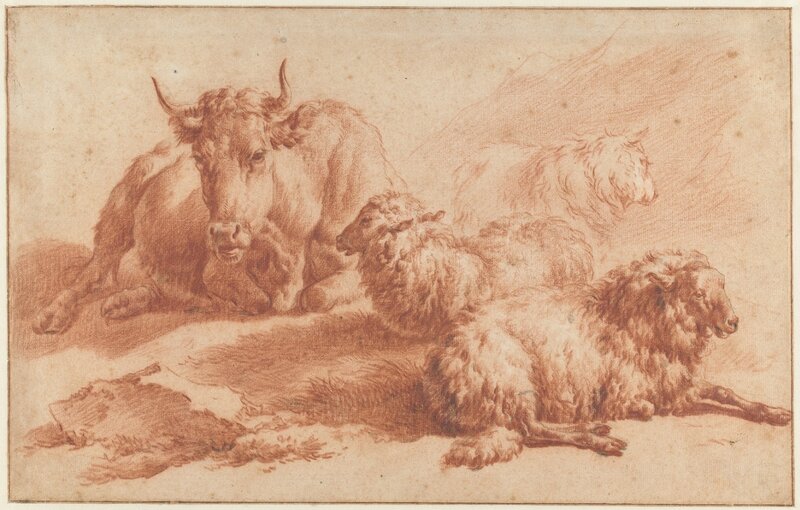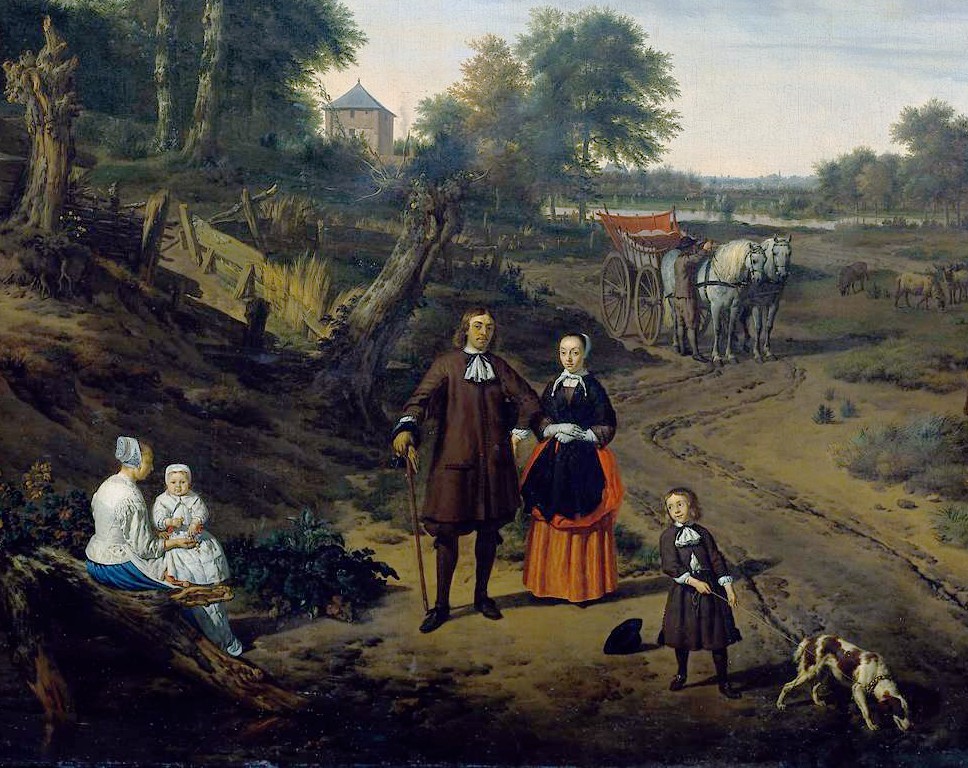Dulwich Picture Gallery
12 October 2016 - 15 January 2017

Adriaen van de Velde, Panoramic summer landscape with a horseman and a post wagon, 1661, Oil on panel, Private CollectionIn collaboration with the Rijksmuseum, Amsterdam, Dulwich Picture Gallery will host the first-ever exhibition devoted to the painter and draughtsman Adriaen van de Velde (1636 - 1672), one of the finest landscape artists of the Dutch Golden Age.
Over a career of less than two decades Van de Velde produced a varied body of paintings and drawings that earned him tremendous posthumous fame in the eighteenth and nineteenth centuries, when he was one of the most sought-after names among collectors in Germany, France and England.
Van de Velde was born in Amsterdam, the son and
brother respectively of the marine painters Willem van de Velde the
Elder and Willem van de Velde the Younger. Adriaen van de Velde,
however, pursued an independent career as a landscape painter to focus
on tranquil landscapes that depict both typically Dutch and Italianising
views populated by figures in peaceful harmony with animals and the
surrounding landscape.
Adriaen van de Velde: Dutch Master of Landscape (12
October 2016 – 15 January 2017) will bring together 60 of his most
accomplished works, including landscapes and beachscapes as well as an
extraordinary selection of exquisite preparatory studies, many of them
in red chalk. Displayed alongside the artist’s paintings, these studies
offer a rare glimpse of a seventeenth-century landscape painter at work,
from conception to completion. The show will also include pen-and-ink
drawings and watercolours that stand alone as works of art in their own
right, revealing the extent of the young artist’s talent.
The exhibition opens with Van de Velde’s most
accomplished paintings, made when the artist was still in his early
twenties. Blissful scenes such as the masterly
Beach at Scheveningen,
1658 (Oil on canvas, 52.6 x 73.8 cm,
© Museumslandschaft Hessen Kassel,
Gemäldegalerie Alte Meister.
introduce Van de Velde’s
highly individual style, in which everything stands out in the pure
light of a summer’s day.
Especially in his later work Van de Velde
succeeded in incorporating the sun-drenched atmosphere of Italianate
painters such as Karel Dujardin in his works, but brought a refinement
to his subjects that was rarely matched by his contemporaries. Van de
Velde probably never travelled outside Holland; the mountainous scenery
and Italianate character of some of his landscapes and drawn studies
sprung from the imagination and were inspired by the work of fellow
artists. Examples include the Pastoral scene from the Museo
Thyssen-Bornemisza, Madrid, and the preparatory composition drawing for
this painting from the Morgan Library & Museum, New York.
Adriaen van de Velde,
The Hut, 1671,
Oil on canvas, 76 x 65 cm, Rijksmuseum, Amsterdam.
The Hut (Rijksmuseum) will be displayed alongside the drawn studies that the artist made in preparation for the painting, providing insight into the work’s genesis.
Such studies include Seated woman with basket and
Resting cow with three sheep (both Amsterdam Museum), as well as a drawing from a private collection depicting the hut that lends the picture its name. These and other studies in the exhibition reveal Van de Velde’s almost obsessive attention to detail and how he proceeded from a rough composition sketch in pen and ink to separate studies of animals and figures from life, often executed in the medium of red chalk.
Few seventeenth-century Dutch landscapists devoted so
much time and energy to sketching from models in the studio and the
exhibition will showcase some of the artist’s remarkable figure studies,
including a sheet with Two Studies of a Reclining Shepherd
(Rijksmuseum), which in its elegance and exquisite use of red chalk
prefigures the work of eighteenth-century French artists such as Antoine
Watteau and François Boucher.
Dulwich Picture Gallery’s Two Churches and a Town Wall (1660s) by Jan van der Heyden, which will feature in the exhibition.
The exhibition includes a selection of the artist’s cabinet-sized works and concludes with his larger paintings. Together they illustrate the enormous variety of subject-matter in Van de Velde’s oeuvre, from panoramic views to hunting scenes, pastoral subjects or depictions of winter.
The larger works include the monumental
Portrait of a Family in a Landscape (Rijksmuseum) a

Adriaen van de Velde,
Landscape with cattle and figures
1664, Oil on canvas, 125.7 x 167 cm,
© Fitzwilliam Museum, Cambridge
Together these works show a Dutch Arcadia as it was imagined by this exceptionally refined artist.
Adriaen van de Velde: Dutch Master of Landscape is
curated by Bart Cornelis, former Deputy Editor of The Burlington
Magazine, London, in collaboration with Marijn Schapelhouman, Senior
Curator of Drawings at the Rijksmuseum.
Biography:
Adriaen van de Velde was baptised in Amsterdam on 30 November 1636. He was the son of the famous marine painter Willem van de Velde the Elder (1611-1693) and brother of the equally renowned marine painter Willem van de Velde the Younger (1663-1707). Adriaen van de Velde was most probably first taught by his father. On 5 April 1657 he married Maria Ouderkerk in Amsterdam, where he most probably remained for the rest of his life. His wife was Catholic and their children were all baptised in clandestine Catholic churches in Amsterdam. He died at the age of 35 and was buried on 21 January 1672 in the Nieuwe Kerk in Amsterdam.
Adriaen van de Velde,
The Angel appearing to the Shepherds
, Brush and brown ink over
black chalk, 17.2 x 20.2 cm, © The
Trustees of The British Museum
Adriaen van deVelde,
Herdsman and herdswoman with livestock
by a stream
, Pen in
brown and black grey wash, 17.7 x 17.7
cm, Teylers Museum, Haarlem, The
Netherlands
Adriaen van de Velde
, Figures in a deer park
c. 1665, Oil on panel, 21.1 x 28.6 cm,
Museum of Fine Arts, Houston, The Edward and Sally
Speelman Collection, TR:1644-2005.
Adriaen van de Velde,
Figures on the beach at Scheveningen
1660, Oil on canvas, 38.2 x 50cm,
Royal Collection Trust / © Her
Majesty Queen Elizabeth II 2015
Adriaen van de Velde,
Seated woman with basket
, Red chalk, 28.3 x 20 cm, Private Collection
Adriaen van de Velde,
Panoramic summer landscape with a
horseman and a post wagon
1661, Oil on panel, 37.8 x 49 cm,
Private Collection.
Carriage on the Beach at Scheveningen, Adriaen van de Velde 1660. Musée du Louvre, Paris.
Adriaen van de Velde,
Two studies of a reclining shepherd, 1666-1671,
red chalk over asketch in black chalk, Rijksmuseum,
Amsterdam.
Purchased with the support of theVereniging Rembrandt













